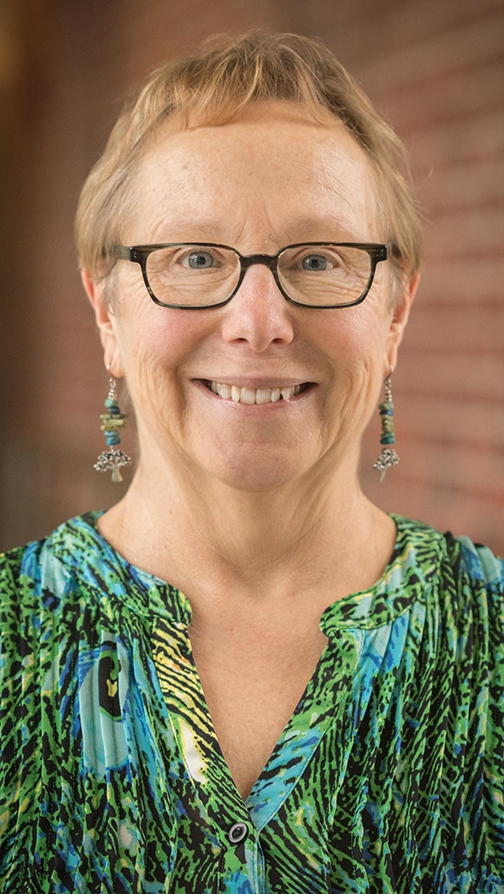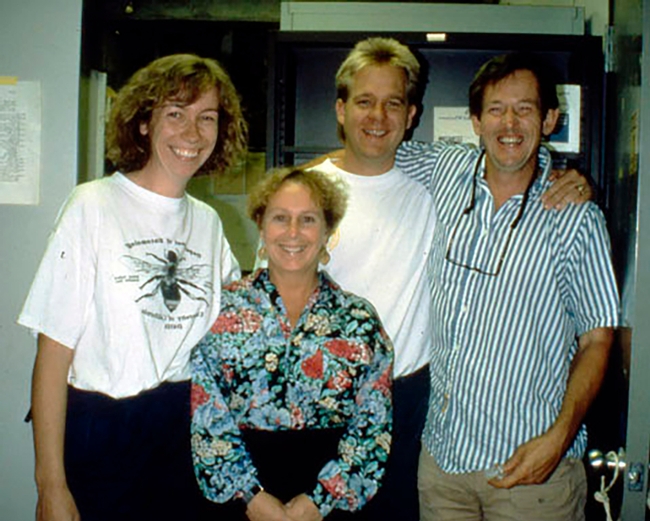- Author: Kathy Keatley Garvey

The 10 Fellows were announced today.
Hoover, who received her doctorate in entomology from UC Davis in June, 1997, studied with major professors Sean Duffey (1943-1997) and Bruce Hammock. Hoover joined the PSU faculty as an assistant professor in 1998, achieving full professor in 2010.
Hoover's areas of expertise include biology and ecology of invasive species, insect-microbial symbiosis, tritrophic interactions, insect virology, and pollination of forest trees.
She is active in PSU's Center for Chemical Ecology, Center for Pollinator Research, and the Insect Biodiversity Center.
“Hoover is internationally recognized for uncovering detailed mechanisms of how phytochemicals reduce mortality by baculoviruses through physiological impacts on the larva's midgut (epithelial cells and peritrophic matrix,” said nominator Gary Felton, professor and head of the PSU Department of Entomology. Hoover and her co-advisors “patented baculovirus formulation additives that counteract these physiological effects, and thus increase the sensitivity of larvae to infections.”
“Kelli was a delight to have in the laboratory at UC Davis,” said Hammock, now a UC Davis distinguished professor who holds a joint appointment with the Department of Entomology and Nematology and the UC Davis Comprehensive Cancer Center. “She started her Ph.D. at Davis at an exciting time when we were trying to move recombinant baculoviruses into practical agriculture as green pesticides. Among the laboratories of Sean Duffey, Susumu Maeda, Kevin Heinz and extramural collaborators around the world, we had an exciting critical mass ranging, including virology, peptide chemistry, scorpion venoms, genetic engineering, pest management and others.”
“Kelli's interest in tritrophic interactions and her outgoing and engaging personality were just what was needed to pull the team together,” said Hammock, a 2010 Fellow. “As one would expect, Kelli's talents in science and leadership have served her well at Penn State. There her baculovirus work transitioned into a broader program in gypsy moth control and the invasion of the Asian longhorned beetle provided an opportunity to look at gut symbionts. Every project that Kelli touches seems to yield exciting results with practical implications. I am thrilled that the ESA has recognized what a star she is in our field.”
UC Davis doctoral alumnus Bryony Bonning, a professor at the University of Florida and a 2013 ESA Fellow, commented that “Kelli is so deserving of this award.”
“I worked with Kelli for two, delightful years at UC Davis, and was particularly impressed by the number of undergraduate students that she managed to mentor at the bench!” Bonning said. “Since then, she has established a stellar research program that has recently focused on both the fundamental biology and management solutions for invasive pests including Asian longhorned beetle (ALB) and spotted lantern fly. Analysis of ALB semiochemicals resulted in a blend now sold by two companies and used in North America and Europe for ALB management."
“In collaboration with engineers, she has also spearheaded development of a method to prevent introduction of invasive species in the wood packing associated with international shipments,” Bonning noted. “This dielectric heating technology, used to treat and kill insects hidden in the wood packing, is at the stage of commercial equipment prototype. These examples reflect both the interdisciplinary breadth of Kelli's research program and the seamless melding of science to address fundamental questions that lead to practical solutions. This breadth of scope and ability to identify commercially useful components of the system is a relatively rare phenotype among entomologists! Further, Kelli is driven to engage the necessary parties (scientists, stakeholders, policy makers) toward implementation of strategies to prevent or manage the impact of invasive species on U.S. agriculture."
In his nomination letter, Felton, a 2014 ESA Fellow, said that Hoover excels in research, teaching, and service. “There are three key attributes that stand out in Dr. Hoover's research contributions: interdisciplinary, collaborative, and integrative,” he wrote. “Hoover's program encompasses research, education, outreach and service related to the biology of and solutions for invasive species threats, in forest, ornamental, and agricultural systems. She integrates basic and applied research in multi-trophic interactions, microbial symbioses, invasion biology, and insect physiology.”
For 19 years, Hoover has collaborated with industrial engineers and national and international regulatory agencies “to develop a novel technology (patents pending) to reduce the risk of pathways that can introduce alien forest pests through international trade,” Felton wrote. “She has used her studies to create a platform for education and training of a diverse group of undergraduates, graduate students, and post-graduate scholars. Since Hoover's interdisciplinary approach allows her to interact with and serve as a bridge between multiple disciplines and diverse stakeholders, she has initiated broad networking opportunities for members of these communities by organizing and leading multi-disciplinary research teams, symposia, and international conferences.”
Asian Longhorned Beetle, Gypsy Moth
“The vast majority of Hoover's studies focuses on basic and applied research on invasive species, such as the Asian longhorned beetle (ALB) and gypsy moth and most recently the spotted lanternfly,” Felton wrote. “Hoover and collaborators investigated semiochemical communication in ALB in an effort to help regulatory agencies detect and monitor ALB in the field, especially at low densities. Hoover and colleagues took the male-produced volatile sex pheromone (discovered by USDA/ARS) and conducted years of basic lab and field research to produce a commercially available ALB lure (pheromones and kairomones) and trapping system, which primarily captures virgin females. The blend developed by Hoover and her team is sold by two major pheromone companies and has been used in North America, Germany, Britain, Switzerland and Italy. She and collaborators also characterized behavioral responses to a putative female-produced trail pheromone that elicits following behavior by males.”
Hoover is also heavily involved in preventing the introduction of invasive species. Her research draws support from governmental grant programs, commodity groups and the private sector. She is currently the principal investigator or co-PI on grants totaling $10 million, with $1.62 million directly supporting her program, Felton said, adding that she has actively collaborated with researchers in Europe, China, Canada, New Zealand, and Australia.
Felton described her as “an effective educator and mentor of the next generation of scientists.”
She has mentored 43 undergraduates, 11 PhD and 10 masters students, and 13 postdoctoral scholars, “many of whom have received prestigious awards and fellowships.”
High Impact Interdisciplinary Research
“While making new discoveries through basic research, she continues to strive to apply the outcomes of that research by actively engaging other scientists, stakeholder groups, and policymakers within Pennsylvania, nationally, and globally to make a difference -- to prevent and/or manage the consequences of invasive species on our ecosystems,” Felton wrote. “Her ability to conduct high impact interdisciplinary research and integrate transformational and translation research is truly outstanding.”
Born in Lubbock, Texas, but raised in the south San Francisco area,Kelli received her bachelor of science degree in 1979 from UC Berkeley, with honors, majoring in the biology of natural resources. She obtained her master's degree in biology, with an emphasis on entomology, from San Jose State University in 1992 before joining the doctoral program at UC Davis. After a year as a President's Postdoctoral Fellow at UC Berkeley, she joined the faculty in the Department of Entomology at PSU in 1998.
Active in ESA since 1996, Hoover has judged student competitions at 10 national meetings. She has organized numerous national or branch meeting symposia and served as a subject editor for Environmental Entomology. She chaired or co-chaired organizing committees for three annual meetings of the International Society for Invertebrate Pathology and held the office of treasurer for four years.
Fellows of ESA are individuals who have made outstanding contributions to entomology— via research, teaching, extension, administration, military service, and public engagement and science policy —and whose career accomplishments serve to inspire all entomologists, according to the ESA, a worldwide organization with a membership of some 7000.




